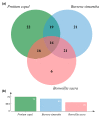Leaf Transcriptome Assembly of Protium copal (Burseraceae) and Annotation of Terpene Biosynthetic Genes
- PMID: 31121954
- PMCID: PMC6563135
- DOI: 10.3390/genes10050392
Leaf Transcriptome Assembly of Protium copal (Burseraceae) and Annotation of Terpene Biosynthetic Genes
Abstract
Plants in the Burseraceae are globally recognized for producing resins and essential oils with medicinal properties and have economic value. In addition, most of the aromatic and non-aromatic components of Burseraceae resins are derived from a variety of terpene and terpenoid chemicals. Although terpene genes have been identified in model plant crops (e.g., Citrus, Arabidopsis), very few genomic resources are available for non-model groups, including the highly diverse Burseraceae family. Here we report the assembly of a leaf transcriptome of Protium copal, an aromatic tree that has a large distribution in Central America, describe the functional annotation of putative terpene biosynthetic genes and compare terpene biosynthetic genes found in P. copal with those identified in other Burseraceae taxa. The genomic resources of Protium copal can be used to generate novel sequencing markers for population genetics and comparative phylogenetic studies, and to investigate the diversity and evolution of terpene genes in the Burseraceae.
Keywords: Protium; RNA-sequencing; copal resin; de novo assembly; terpenoid.
Conflict of interest statement
The authors declare no conflict of interest.
Figures





References
-
- Langenheim J.H. Plant Resins: Chemistry, Evolution, Ecology, and Ethnobotany. Timber Press; Portland, OR, USA: 2003. No. 620.1924 L275p.
-
- Stacey R.J., Cartwright C.R., McEwan C. Chemical characterization of ancient mesoamerican copal resins: Preliminary results. Archaeometry. 2006;48:323–340. doi: 10.1111/j.1475-4754.2006.00259.x. - DOI
-
- Cheng A.X., Lou Y.G., Mao Y.B., Lu S., Wang L.J., Chen X.Y. Plant terpenoids: Biosynthesis and ecological functions. J. Integr. Plant Biol. 2007;49:179–186. doi: 10.1111/j.1744-7909.2007.00395.x. - DOI
Publication types
MeSH terms
Substances
LinkOut - more resources
Full Text Sources

